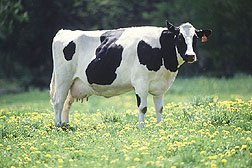This page has been archived and is being provided for reference purposes only. The page is no longer being updated, and therefore, links on the page may be invalid.
Sequencing Vital in Developing New Tests for Johne's Disease
By Luis PonsSeptember 19, 2005
Genome sequencing by Agricultural Research Service (ARS) and University of Minnesota (UM) scientists was vital in the development of new tests that rapidly detect and differentiate bacteria that cause Johne's disease.
Johne's, a chronic wasting affliction of cattle and other ruminant animals, costs the U.S. dairy industry about $200 million a year in reduced milk production. It is caused by infection with Mycobacterium avium subspecies paratuberculosis (M. paratuberculosis).
The new tests directly resulted from the genomic sequencing of M. paratuberculosis by researchers at the ARS National Animal Disease Center (NADC) and UM two years ago. The tests enable detection within 72 hours of the microbe in animals' fecal matter or milk. Previous tests often took between six and 18 weeks to process because of the bacterium's slow growth in the laboratory.
The novel tests were developed independently by NADC microbiologist Judith Stabel; Vivek Kapur, director of UM's Advanced Genetics Analysis Center; and colleagues.
The genome research at NADC was a key to the achievement. There, microbiologist John P. Bannantine led the ARS team on work to identify at least 39 novel coding sequences unique to the M. paratuberculosis microbe.
The identification of these coding sequences, which made the new tests possible, was made through the use of data garnered when Bannantine and Kapur spearheaded the sequencing of the M. paratuberculosis genome.
By helping detect and isolate infected animals more quickly, the new tests will help curb animal-to-animal transmission of Johne's and lessen the economic impact of the disease.
Bannantine was assisted by Stabel and NADC microbiologists David P. Alt and Michael L. Paustian. According to Bannantine, the research shows how genome studies can lead to highly effective tests for detecting infectious diseases in animals.
The scientists see this research, published recently in the Proceedings of the National Academy of Sciences, as a portal to a better understanding of the Johne's disease process and the design of vaccines against it.
ARS is U.S. Department of Agriculture's chief scientific research agency.

